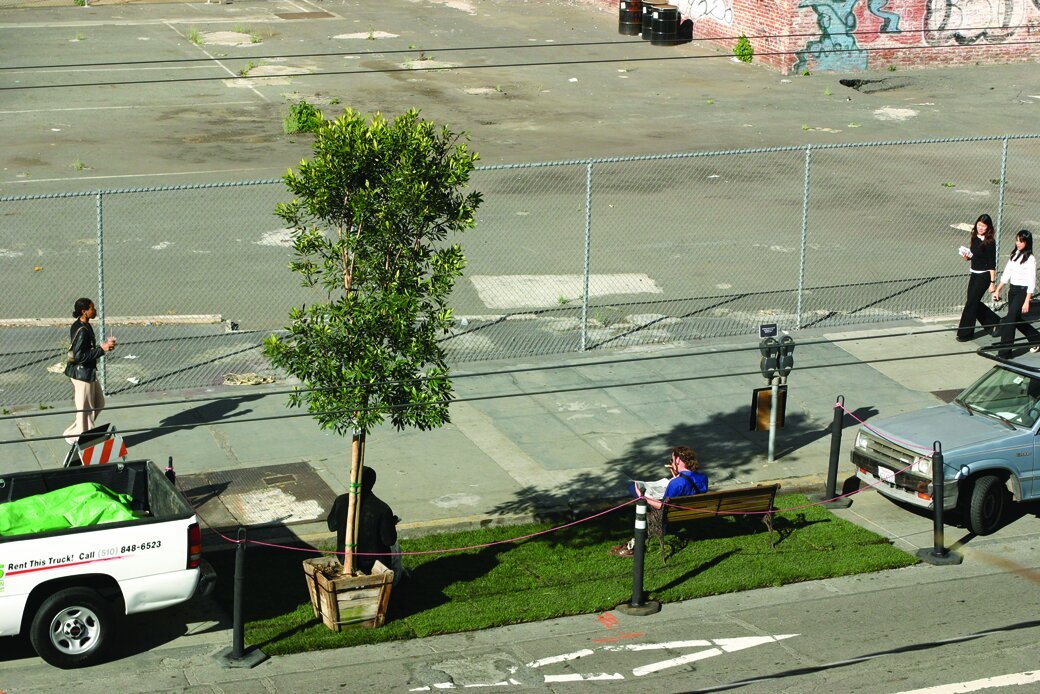
The Park(ing) Day Network is a global initiative dedicated to transforming urban curbside parking spaces into vibrant, temporary public spaces for art, play, and activism.
Originating in 2005 with a single installation by Rebar Art and Design Studio, Park(ing) Day has grown into a participatory event engaging communities on six continents. It highlights issues like climate change, road safety, and mobility equity, offering a platform for reimagining streets as greener, safer, and more equitable spaces for people. Through its online resources, including a global map, how-to guides, and partnerships with organizations like the Trust for Public Land and SPIN, the network empowers participants to take direct action, fostering local activism and inspiring long-term urban transformation.
The Park(ing) Day network is fiscally sponsored by ISI, a 501(c)(3) nonprofit organization, and all donations are tax-deductible to the fullest extent allowed by law.
The following year, in partnership with the Trust for Public Land we launched Park(ing) Day, an annual event for people to reclaim urban space from cars, one parking space at a time. The project spread and grew to hundreds of cities and thousands of participants every year, and still continues to spread across the globe.
In 2009, inspired by Park(ing) Day and the New York City temporary plaza program, representatives of Mayor Gavin Newsom’s Department of Greening commissioned Rebar and several other design firms to create a more permanent version of a park in a parking space. Our invention, a modular system of seating and planting was named Walklet. The city of San Francisco renamed the early projects Parklets and the City of San Francisco’s Parklet program, part of the Pavement to Parks (now Groundplay SF) was born.
Motivated by the desire to exploit the metered parking space as a site for art, activism, and cultural expression, Rebar created Park(ing) as a prototype for open source urban design accessible to all. In response, thousands of people around the globe have created hundreds of parks and formed an international event: Park(ing) Day. The event continues to grow. Park(ing) Day has become a global experiment in reprogramming vehicular space for social exchange, artistic expression, and play.
The Origin Story
Inspired by Gordon Matta Clarke’s Fake Estates project, Matthew, John and Blaine - the group that would become Rebar - began seeking niche spaces in San Francisco. We began discussing parking spaces in San Francisco and determined that at the curbside meter rates, a parking space was an incredibly cheap piece of San Francisco real estate. Furthermore, in researching the SF Parking code, we determined that it was not illegal to put something other than a car in a parking space. Calculating that between 20-30% of San Francisco's land area was streets, and that minus the sidewalk, 70-80% of that space was dedicated to vehicle movement and storage, we began to discuss ideas for more useful ways of occupying this precious part of San Francisco’s public realm.
Careful to document the installation with photos and video, shortly after the intervention, Andrea Scher, Matthew’s former partner, was kind enough to post images of the piece on her website. Soon thereafter we began receiving expressions of interest from people around the globe interested in recreating the piece. John suggested that we create an Ikea-like how-to-manual describing the ethics and the process of creating the piece and we invited anyone anywhere to use it. Using the How to Manual as a guide, Park(ing) installations began to appear around the globe.
Early sketches included an 8’x20’ outdoor office space, an urban forest, a cabaret, and other ideas. (see napkin sketch). John sketched up an idea for an urban park in a parking space and dubbed it Park(ing). After several rounds of meeting and discussion at the Latin American Club in the Mission we chose a time and location, and on November 16, 2005 we installed the world’s first Park(ing) installation at 1st and Mission in San Francisco.

